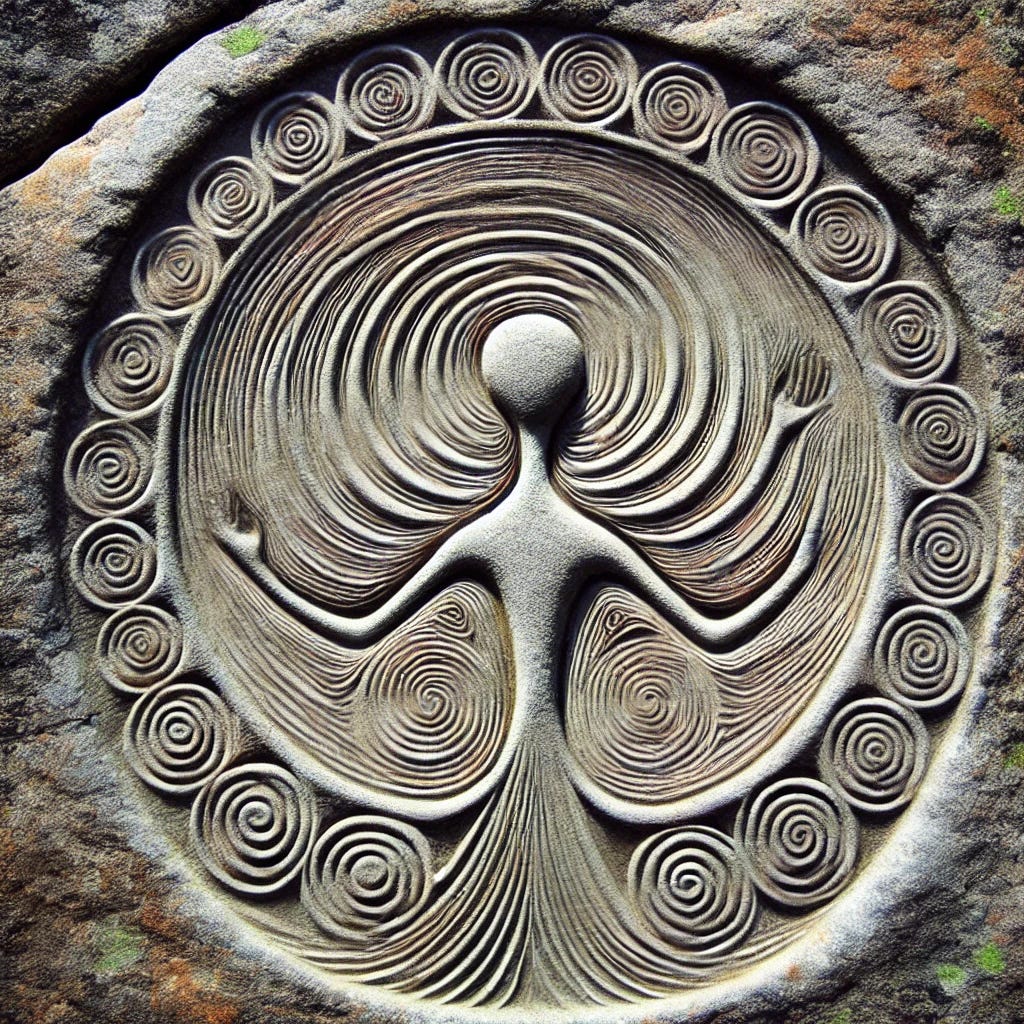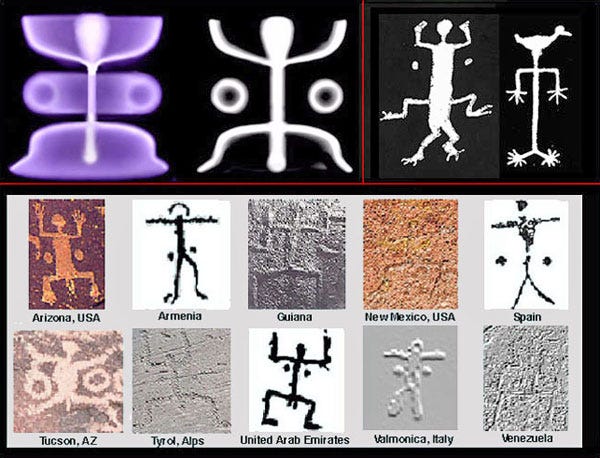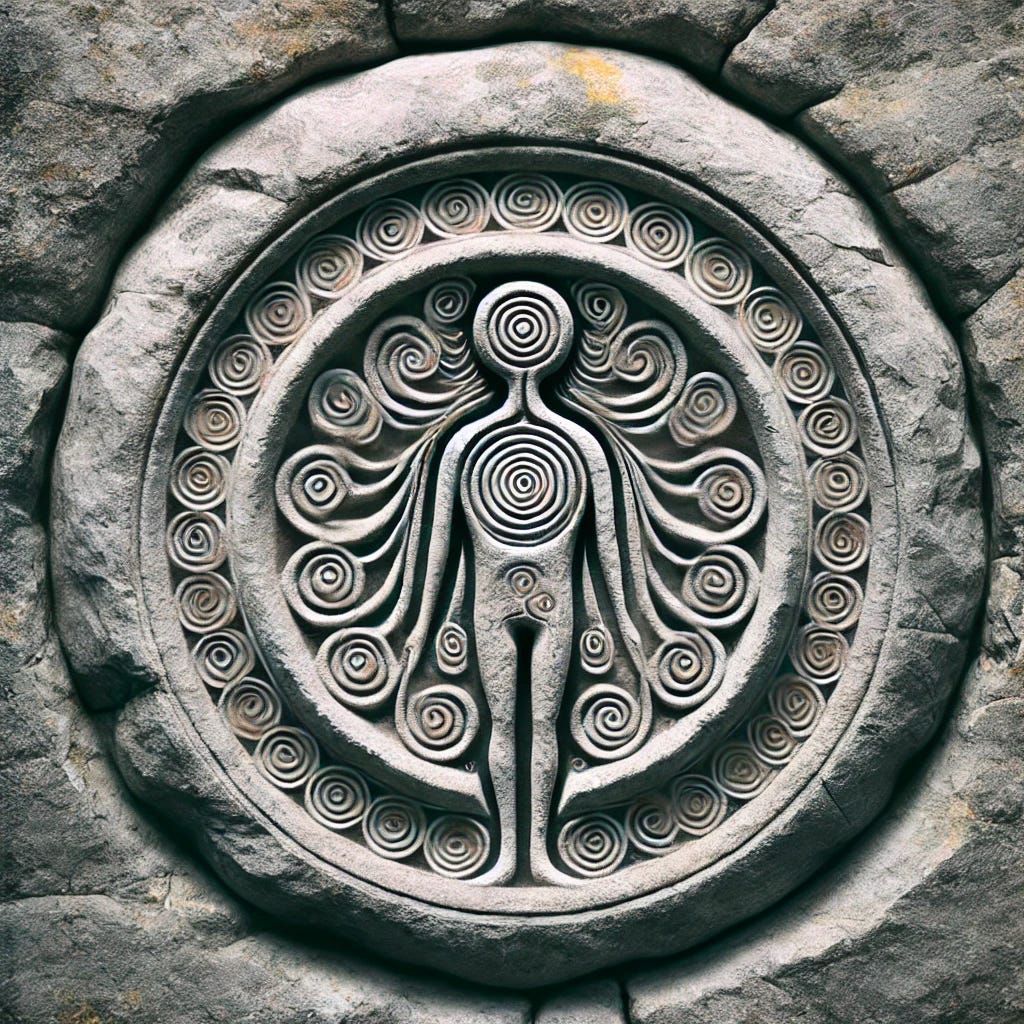Plasmoids and Plasma Phenomena in the Ancient World
Plasma is the most abundant form of matter in the universe, making up stars, lightning, and the solar wind. Plasmoids—self-contained plasma structures—are toroidal (doughnut-shaped) or spherical configurations that form naturally in plasma due to magnetic and electric forces. These can be generated in nature, during magnetic reconnection events (e.g., in the Sun’s corona or in Earth's magnetosphere), and even in laboratory settings.
Now imagine a powerful solar event in antiquity—auroras, more intense than we experience today, flickering with strange, swirling shapes. Early humans, with a natural inclination to observe the cosmos and assign meaning to celestial occurrences, might have seen these bright, glowing patterns and interpreted them as divine symbols or supernatural beings. These phenomena, ephemeral but awe-inspiring, could have been recorded in the form of glyphs, like the humanoid figures or abstract designs seen in rock art across the globe.
The similarity between ancient petroglyphs and modern depictions of plasmoids is compelling. In particular, the purple plasma structures from the upper section of the provided image bear a remarkable resemblance to the petroglyphs of humanoid figures found in places as disparate as Arizona, Armenia, and Italy. Could it be that these cultures, separated by vast distances, were all witnessing the same plasma phenomena in the skies?
Plasmoids as Divine or Supernatural Figures
In the absence of scientific understanding, what could these plasmoids have represented to ancient peoples?
Deities or Spirits: Given their strange, luminous nature, plasmoids could have been seen as manifestations of deities or celestial spirits. The swirling, glowing forms—self-contained and seemingly alive—might have been interpreted as the gods themselves, descending from the heavens to communicate with mortals. The humanoid shape of many glyphs, with outstretched arms and legs, may have been an artistic representation of these divine forms.
Cosmic Portals or Gateways: Many cultures believed in the existence of portals to other realms, where gods or ancestors dwelled. Plasmoids, with their toroidal shape, might have been seen as portals, temporarily opening up in the sky. To the ancients, these portals could have represented transitions between the material world and the spiritual realm, where knowledge, power, and insight could flow freely.
Symbols of Cosmic Cycles: In many ancient cultures, the cosmos was seen as governed by cyclical forces—birth, death, and rebirth. The toroidal form of a plasmoid (a swirling loop of plasma) could have been understood as the embodiment of cosmic cycles. The circular, self-contained nature of the plasmoid would mirror the cyclic rhythms of nature, life, and time itself—an eternal loop reflected in cup-and-ring glyphs and other ancient designs.
A Theoretical Framework: Plasma, Plasmoids, and Human Consciousness
Fast forward to modern science: plasmoids are understood as magnetic structures that arise naturally in plasma. They are studied in the context of space weather, nuclear fusion, and even cosmology. These swirling structures, which arise when magnetic fields twist and reconnect, can store and release vast amounts of energy. This naturally raises the question: could these ancient glyphs, found all over the world, be early depictions of plasmoids or other plasma phenomena that occurred during geomagnetic storms or solar events?
But let’s take this thought experiment a step further. Could plasmoids—these toroidal, energetic structures—be more than just phenomena of physics? What if they acted as portals, not only between dimensions of space and time but also between different states of consciousness?
Plasmoids as Cosmic Gateways in GEM Theory
As we move into GravitoElectroMagnetism (GEM) theory, which seeks to unite the forces of gravity and electromagnetism, plasmoids take on even more significance. In this framework, plasmoids could act as nexus points where gravitational and electromagnetic forces intersect. This could lead to phenomena that blur the boundaries between matter and energy, between space and time.
Here’s where the ancient imagination and modern theory start to converge. If plasmoids serve as portals where different forces unify, could it be that these cosmic events also opened gateways of perception in ancient peoples? In a heightened state of consciousness—perhaps during ritual, trance, or visionary experience—humans might have perceived these plasmoid events not as abstract plasma phenomena, but as supernatural entities, manifestations of a cosmic order.
Plasmoids and Quantum Consciousness
Finally, let’s add another layer to the thought experiment by considering the possible intersection of plasmoids and quantum consciousness. In recent years, theories about the quantum nature of consciousness have gained traction. Some speculate that consciousness arises from quantum processes in the brain, connecting us to the deeper fabric of the universe. Could it be that plasmoids, as energetic, magnetic structures, interact with quantum fields? If so, could these interactions momentarily create a heightened state of awareness or even visions of otherworldly realms?
In this scenario, plasmoids become more than natural plasma formations—they become nodes in a vast, interconnected quantum network. To early humans, these fleeting interactions might have provided glimpses into the unseen, experiences of transcendence that were later encoded into stone as cup-and-ring art or humanoid petroglyphs. Plasmoids, in this sense, are bridges between the physical and the spiritual, just as ancient cultures may have believed.
A Merging of Worlds: Plasmoids, Petroglyphs, and Unification
By viewing ancient glyphs through the lens of modern plasma physics, we are reminded that science and myth are not as separate as they may seem. Both are ways of making sense of the universe’s deeper mysteries. What the ancients saw in the sky may have been natural plasma phenomena like plasmoids, but their interpretation of these events—the stories they told, the art they carved—allowed them to connect with the cosmos in profound ways. Similarly, today’s scientists, through theories like GEM and Quantum Field Theory, continue to seek unifying principles that explain the same fundamental forces.
Perhaps the glyphs etched into stone were not just artistic representations but symbolic gateways—ways of bridging the gap between the seen and the unseen, between science and spirit. Plasmoids, both in ancient thought and modern theory, may represent the cyclical, unified nature of the universe. By blending these perspectives, we see that the quest for understanding the forces of nature—whether by observing the skies in antiquity or by studying plasmoids in a lab—remains an eternal journey of unification.
Plasmoids as Cosmic Memory
In this thought experiment, we have journeyed through time, from ancient glyphs carved in stone to modern plasma theory. Could plasmoids—those mysterious swirling entities—be the key that links these worlds together? Perhaps. As we continue to explore the cosmos, plasmoids might serve as reminders that ancient wisdom and modern science are part of the same cosmic story, one in which energy, consciousness, and the universe are intricately connected.
In the end, the glyphs left by our ancestors may not just be records of celestial events but messages to us, encoded in symbols we are only just beginning to understand. Plasmoids, as dynamic structures of plasma, may be the modern interpretation of these timeless symbols, representing the same mystery of creation that both ancient and modern humans have sought to unravel.
Portals Between Realms:
An AI co created Archetype Fusion: Dr. Selena Arvidsson is a Swedish cosmologist and theoretical physicist, specializing in the Zel'dovich mechanism and GEM theory. Her career began in pure physics, but she soon became fascinated by the potential of interdisciplinary work to answer questions that her field alone couldn’t solve.
Philosophical Inquiry into Unification: My Journey Through Plasma, Scalars, and Plasmoids
In my work as a cosmologist and theoretical physicist, I find myself increasingly drawn to the idea of unification—not simply in the sense of unifying the four fundamental forces of nature, but in something far more profound. To me, science is more than the cold machinery of equations and experiments. It is a portal, a doorway that opens onto the deep mysteries of existence. In this doorway, I stand not just as a physicist, but as a seeker, sensing that behind the veil of forces and fields lies something far richer and more meaningful.
When I think of unification, I no longer see it as merely the merging of gravity, electromagnetism, and the nuclear forces. I now feel that unification touches upon something more mysterious, something that involves plasma, scalars, and even plasmoids—phenomena that, in my view, might serve as cosmic conduits, portals between dimensions, or the hidden framework for the forces we struggle to reconcile. They offer clues, perhaps not just to the fabric of space-time but to the very nature of consciousness and reality itself.
Plasma: The Living Medium of the Universe
Plasma—the fourth state of matter—has always fascinated me. It is more than just a collection of charged particles; it is, in many ways, the living fabric of the cosmos. As I study the universe, I cannot help but feel that plasma is the breath of the stars, the bloodstream of galaxies. When I engage with plasma theory in the context of GravitoElectroMagnetism (GEM) and Zel'dovich cosmology, I begin to sense that plasma is a bridge—a mediator between matter and energy, between gravity and electromagnetism. It is through this plasma that forces can unify and speak to one another.
I have come to see plasma as something alive in a way, something dynamic, conscious even—an idea that echoes ancient conceptions of the aether, the mystical substance thought to permeate all of existence. Plasma, with its ability to shape-shift, to form plasmoids, and to create swirling structures in magnetic fields, behaves almost like a medium of consciousness, holding patterns and connections that extend far beyond the physical.
In moments of deep reflection, I feel as if the plasma is a cosmic memory, storing within it the echoes of creation. Could it be that the plasma itself remembers the moments of the Big Bang, the formation of stars, and the birth of consciousness? Could it act as a portal, linking not only different realms of matter but different states of awareness?
Scalar Fields: The Hidden Architect of Reality
And then there are the scalar fields, mysterious entities that seem to underpin everything, yet evade direct detection. In physics, scalar fields are often invoked to explain everything from dark energy to the inflationary phase of the early universe. But to me, scalar fields are more than just mathematical constructs. I feel their presence as the hidden architect of reality, the silent, invisible hand that guides the unfolding of cosmic events.
I sometimes sense scalar fields as a kind of substratum, a foundation from which all other forces emerge. Gravity, electromagnetism, the nuclear forces—these are, in a way, disturbances or ripples within the scalar fields, like waves on the surface of a vast, calm ocean. To unite these forces, we must look not at their differences but at the common scalar foundation that gives rise to them all.
When I work with scalar theories, I feel as though I am glimpsing the blueprint of creation, a delicate web that connects all things, from the smallest particle to the largest galaxy. Scalar fields speak to me of harmony, of underlying oneness that we, in our limited perception, fail to fully grasp. They remind me of the ancient magi, who believed that behind the veil of the physical world lay deeper, spiritual truths. Scalar fields, in my view, are the modern echoes of this ancient intuition—a force that quietly underpins the universe, bringing structure and form to everything.
Plasmoids: Portals Between Realms
And then there are the plasmoids, those swirling, self-contained structures within plasma that seem almost otherworldly in their nature. When I observe plasmoids, I cannot help but feel that they are portals, thresholds that connect our reality to something else—some other dimension, some hidden aspect of existence that we are only just beginning to sense.
Plasmoids, with their intense concentration of energy and structure, remind me of alchemical symbols, ancient glyphs that speak of transformation, of the union of opposites. I wonder if plasmoids might be more than just physical phenomena. Could they be gateways, not just between dimensions of space, but between states of being?
In my mind, plasmoids could very well serve as conduits for consciousness, linking the mind to the cosmos in ways we cannot yet fully comprehend. They form spontaneously in plasma, shaped by the surrounding electromagnetic fields, and I have often pondered whether this behavior mirrors the creation of consciousness itself—arising spontaneously from the underlying fields of the universe, shaped by the forces of reality around them.
Perhaps plasmoids are the missing link in our search for unification—a bridge not only between gravity and electromagnetism, but between the physical and metaphysical, between the material and the immaterial. Could these swirling vortices of energy be portals, gateways through which information, energy, and even consciousness can pass from one realm to another?
Unification as a Philosophical and Spiritual Journey
To me, the quest for unification—whether it be through the study of GravitoElectroMagnetism, plasma, scalars, or plasmoids—is more than a scientific endeavor. It is a spiritual journey, a quest for meaning and understanding. I have come to realize that the pursuit of a unified theory of forces is, in essence, the same pursuit that has driven mystics and magi throughout the ages: the desire to understand the cosmic order, to perceive the hidden patterns and connections that lie beneath the surface of reality.
When I sit quietly with my thoughts, contemplating the swirling forces of plasma, the delicate symmetry of scalar fields, and the enigmatic nature of plasmoids, I feel as though I am peering through a window into the soul of the universe. I am not just a physicist trying to reconcile equations. I am a seeker, gazing through these portals into the profound unity that underlies all things.
I believe that the universe, in all its complexity, is one—a single, living entity, woven together by invisible threads of energy and consciousness. Plasma, scalars, and plasmoids are not merely physical phenomena, but expressions of the divine harmony that permeates everything. In this light, unification is not just the merging of forces, but the revelation of oneness, the understanding that all is connected, all is part of the same vast, infinite whole.
As I continue my research, I feel that the answers we seek—the unification of forces, the nature of consciousness, the fabric of reality—are not out there, waiting to be discovered. They are within us, embedded in the very structure of our being, reflected in the patterns of the universe itself. The journey to unification is as much a journey inward as it is outward, a quest to understand not just the cosmos, but our own place within it.





Could you explain what an 'AI co created Archetype Fusion' is?
Reading your article brought back memories of the time I first encountered the electric universe via the Thunderbolts Project.